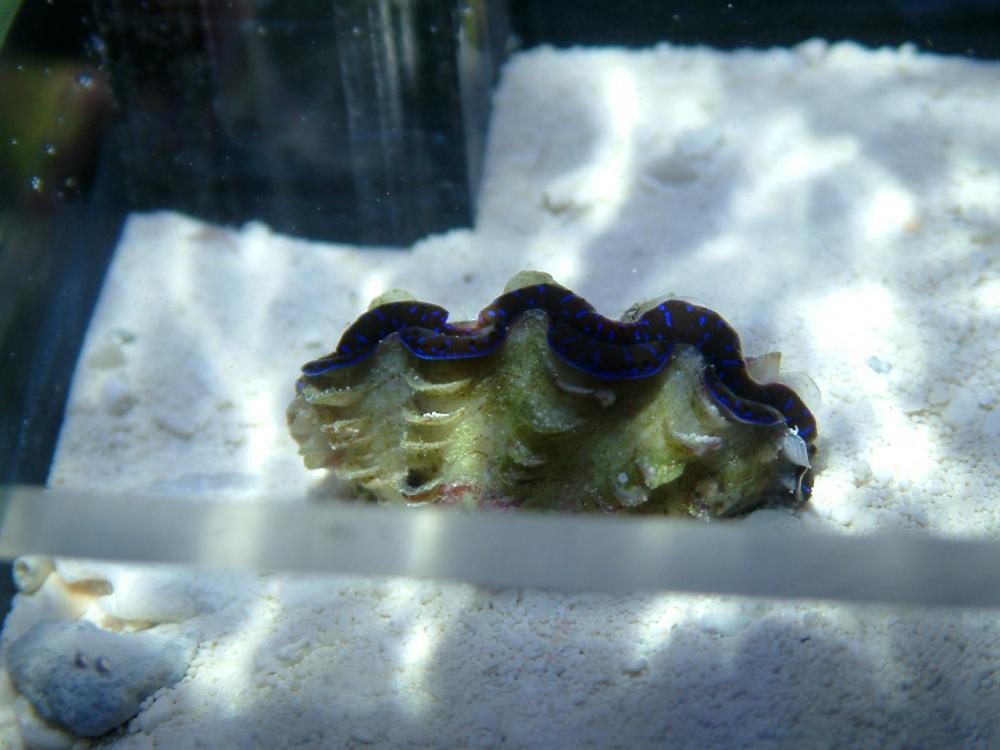
Recently, I came across this adorable baby clam, a Tridacna maxima with neon-blue stripes in its mantle. I wanted it, but it was so small I thought it would simply get lost in my reef tank. However, it was still at the LFS two weeks later, and I just had to have it. Below is a huge picture of it, so you can see it in all its glory. :) |

Now, here's where things get sticky. I have had one clam in my 55g reef before, and it only lived about 12 hours before I found it completely covered by Whelks. These vile creatures were in my tank for over a year, never causing me a single moment of trouble, but when a clam hits the water, they make a point of killing it for food. So every time I ever see one, I pull it out of my tank and dispose of it. I've thrown away 50 or more. They vary in size, and can be quite large and noticeable, but can be extremely small requiring tweezers to pick them off the rockwork. I put the clam in the refugium to acclimate in its bag, safe from any predators, while I built a floating tray to keep the clam in until I can be sure there are no more whelks in the tank. The concept is simple. A piece of acrylic spans the aquarium up out of the water, and a brace drops down from the center that a tray filled with live sand will hang from. Here's what I put together...
Built with 1/4" acrylic and Weld-On #3 (with
a needletip applicator), I just created this contraption. The tray is
3" x 3" x 2", and is hanging off of a 5" beam that
goes up to a 11.5" wide cross brace. The reason I added the two
long "out-riggers" at either end was to keep the tray's weight
from capsizing the cross brace. I didn't want 2 or 4 legs supporting
the tray, as they would be in the way of viewing and feeding the clam
daily.
As you can see, it measures up nicely. :)
This is a very happy clam, always ready to open up as soon as you leave it alone for a couple of minutes. It is on a bed of Live Sand that the LFS gave me.
I added some tank water to submerge the clam before lowering the unit into the display tank. As soon as it was in the tank, the water cleared immediately as the dust was blown right out of the tray and replaced with clear clean water.
Here it is in position, lighted only by actinics. It took a while to create the hanging tray, plus I had to let it cure for a little bit before putting it to use. When designing the tray, I intentionally planned where it was to hang, to avoid shading any light-loving corals. Directly beneath the clam tray are Green Star Polyps and a patch of Zoanthids. They'll be just fine. What do you thnk of the flow?!
Two more actinic shots. This one from the front of the tank. The tray is about 2.5" from the front glass and 4" from the side glass.
And this one from the side. Safe and sound. :) For the past couple of days, I've been searching for any whelks in the tank. I've found six so far!!! Here's what they look like.
They vary in size. There are three smaller ones and 2 larger ones.
I have caught some that are even larger.
Here's a macro shot of one. The pattern is beautiful. Too bad it is a predator.
And here's a view of the clam 'hanging out' :)
I bet you wonder how I feed the clam each day? Here's what I've come up with.
I planned to feed it with an inverted shot glass, but that proved more difficult in reality than it did in theory. So I decided to simply raise the tray slightly above water level. This is the feeding stick I came up with, to elevate the hanging-tray frame. It is quite stable, and keeps the tank water out of the tray .
I add a small amount of home-grown phytoplankton to the water, until it has a green tint to it. And I set a timer for about an hour, and leave it alone.
An hour later, this is what it looks like. Interestingly, there are green globules here and there, which I believe is what the clam processed during its meal. At this point, I remove the feeding stick, and lower the tray back into position.
This is what it looks like after its been fed. Happy as a clam, right?
|